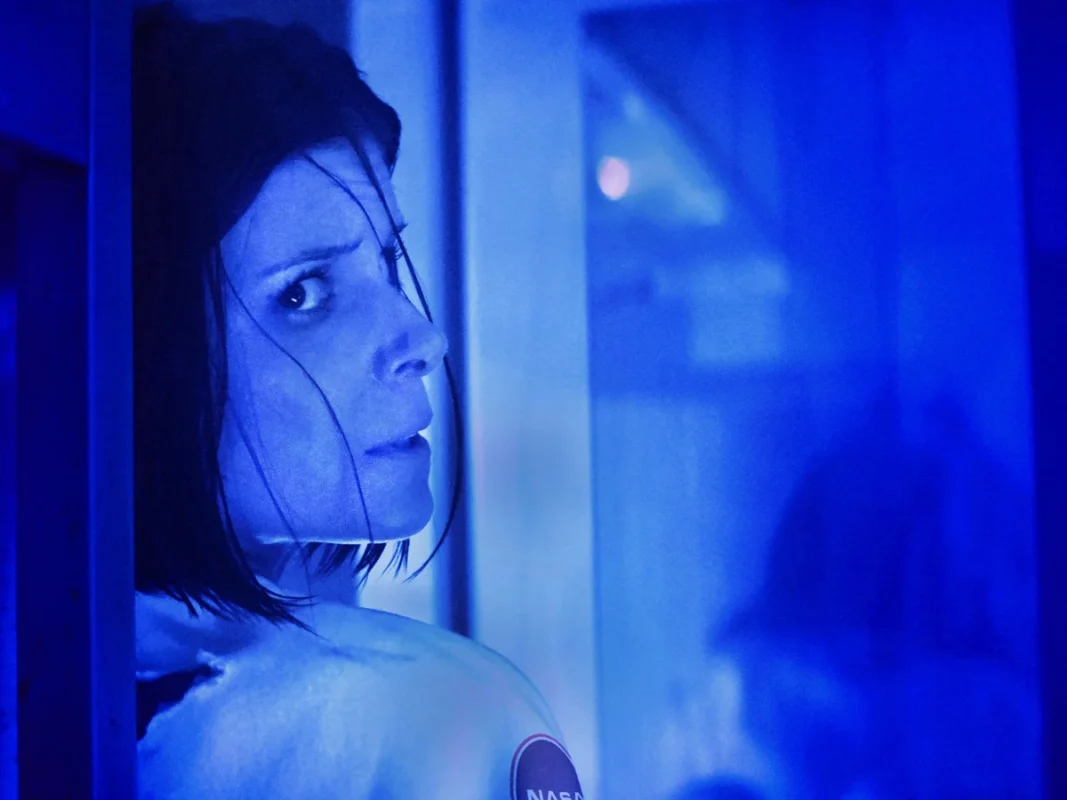Jess Varley’s The Astronaut (2025) is a quiet, disorienting study in cosmic melancholy — a science-fiction drama less about marveling at the stars than about dreading the moment they begin to whisper back. Beneath its mystery-thriller façade lies a story of identity, dislocation, and the aching paradox of home — how the place we long for can become the place we can no longer return to. For Sam Walker, the astronaut at its center, the question turns deeply personal and haunting: what happens when your body remembers something your mind refuses to believe ever happened?
Spoilers Ahead
The Astronaut (2025) Plot Summary & Movie Synopsis:
The film begins with a NASA recovery team pulling a scorched reentry capsule from the Atlantic. Inside is Sam Walker, alive but disoriented, her body behaving like it hasn’t fully returned to gravity. She is ushered into a NASA medical wing, where the first omen arrives: a small object floating beside her bed, as if Earth’s physics is still negotiating her return. Sam is greeted by her father, William Harris, a NASA official, and her husband Mark, along with their daughter Isabel. But instead of going home, Sam is moved to a sleek, isolated rehab facility deep in the woods. It resembles a retreat but functions like a lab. Every wall feels like a one-way mirror.
From the moment Sam is placed there, her sense of reality begins to slip. She experiences tinnitus when looking at the sky, wakes up from hallucinations, and discovers a strange bruise on her hand that gradually spreads across her body like oil blooming in water, its texture subtly iridescent. She’s bleeding, shedding, transforming.
Yet she hides all of it because one truth terrifies her more than any symptom: reporting them might destroy her chances of returning to space. Sam confides in Val, a fellow astronaut, who reinforces the culture of silence around post-mission symptoms. ‘Don’t say anything unless you want to get grounded forever,’ Val warns. For Sam, who treats space like a calling, this fear outweighs her instincts.
But the house is wrong. There are nightly intrusions. Surveillance detects more bodies than should be present. Sam feels watched by something that doesn’t trigger alarms. Something that isn’t considered ‘other’ by the system monitoring her. When she finally breaks and tells Mark everything, he tries to reassure her, the way a spouse tries to hold together a person slipping through their own fingers.
But even he repeats the NASA line: finish rehab, stay compliant, don’t risk being ‘lost.’ Soon after, Sam’s symptoms escalate to the point she flees into the forest. Mark and Isabel chase her, Harris trailing behind them with the urgency of someone who knows far more than he’s said. In the clearing, Sam meets an alien entity. It speaks to her in a language no human should understand, yet Sam responds instinctively. Harris demands that the entity be captured. The aliens counter with an offer: Sam can come with them.

Sam begins shifting, her body completing the transition hinted at since splashdown. And in a moment that fractures everything, Harris blurts the truth: Sam isn’t who Mark thinks she is. Sam isn’t even human. Something inside Sam recognizes the aliens. She steps toward them. Toward what might be her real family. Mark and Isabel watch helplessly as she boards the waiting craft. The ship rises. Harris collapses. And Sam leaves Earth behind not as an astronaut returning to space, but as something finally going home.
Why Does Sam Feel So Alien After Returning to Earth?
Sam’s psychological unraveling isn’t random; it’s patterned. Every sign points to her body rejecting Earth: gravity doesn’t behave around her, her senses glitch, her skin mutates, and her memories feel erased. She isn’t simply readjusting. She’s incompatible. Sam’s hallucinations serve two purposes in the narrative.
On the surface, they’re symptoms of a post-mission condition. Underneath, they’re subconscious memories surfacing as distorted warnings. She is remembering the ‘wrong’ life, the alien life that is deeply embedded within her. Her father’s insistence on controlling her environment only worsens this dissonance. The rehab home is less a recovery center, more a containment facility, built not to heal her but to prevent her from discovering what she already is. Every moment she spends there is a tug-of-war between two identities: the human she believes herself to be and the alien she is becoming.
Why is Harris So Desperate to Keep Sam Isolated?
Harris isn’t protecting her. He’s hiding a truth. He reveals the key twist: during Sam’s supposed reentry, meteor debris breached the pod, and she was found inside. But not the Sam who left Earth. A different Sam. An adopted Sam. The implication is chilling. Sam may never have been human. Harris took her in after an alien uprising, raising her as a replacement child. A secret. A living lie or a being he hoped could assimilate, so long as she remained ignorant of her origins. His strict boundaries, his refusal to let her go home, and the increasingly militarized tone of his concern all make sense through this lens. He isn’t afraid Sam will get hurt. He’s afraid Sam will remember, and once she does, nothing can keep her tethered to Earth.
Also Read: Did These Films Predict the Future? How Sci-Fi (And Other) Cinema Made Curiously Real Assumptions
What Exactly Does the Alien Tell Sam?
The alien’s message is heartbreakingly simple: You were part of us. You were separated. We’ve been waiting for you. They claim Sam was trapped during their rebellion, taken by the government, and raised by Harris. Her human life wasn’t a life. It was a borrowed narrative. The reason the aliens don’t hurt her? Because she’s one of them.
The reason she understands their language? Because her mind never forgot. The reason her symptoms worsen? Because her biology is waking up. Whether this is literally true or metaphorically true is one of the film’s central ambiguities. But emotionally, it lands: Sam is a person without memories, constantly on the verge of dissolving. The aliens give her the first stable identity she’s been offered.
Is Sam Truly an Alien, or is this All in Her Mind?
Here, the film opens its biggest interpretive door.
Theory 1: The literal reading
Sam is an alien child raised as a human. Her symptoms are biological truth returning. The aliens are her species reclaiming her.
Theory 2: The symbolic reading
Sam is experiencing a profound breakdown after reentry. Her hallucinations are trauma, isolation, and an identity crisis taking physical form. She invents the aliens because alienation itself has devoured her sense of belonging. Harris becomes the villain because he embodies every institution that stripped her autonomy. The aliens become ‘family’ because she cannot reconcile the person she was before space with the person she is now.

Theory 3: A cosmic-horror hybrid
Sam may have been altered in space: not replaced, not delusional, but changed. The alien entities represent a biological evolution she can’t resist. The ending becomes an allegory for post-traumatic dissociation: leaving Earth is symbolic of leaving who she once was. The film refuses to confirm any theory. Its power lies in letting all three coexist.
The Astronaut (2025) Movie Ending Explained:
Why Does Sam Leave Earth?
The final moment is not about aliens or conspiracies. It’s about identity. Sam stands between two worlds: the family that loves her but no longer recognizes her, and the beings who claim her but whom she cannot remember. Harris watches with the horror of a man losing control of a secret that has been decades in the making. But Sam walks toward the spaceship because every atom of her body is telling her: this is where you belong. Her transformation is not forced, but a choice.
The ship ascends, leaving Earth below like a memory shedding its last fragment. Whether Sam ascends as a cosmic being returning home or as a fractured mind retreating into the ultimate hallucination, the effect is the same: she leaves because she can no longer fit inside the shape of the life she was given.
The final few moments in the film are anchored in a singular notion. As Sam learns, sometimes home is not from where you are; it’s to where you finally arrive and stop feeling strange. Sam is not trying to grapple with a new meaning or identity. She’s trying to confront the identity she has always felt was underneath her skin. That meaning is rich and multifaceted regardless of whether it is literally true or figuratively conceptual. “The Astronaut” concludes in a fever dream because this film is not interested in delivering retrospective conclusions. This film is interested in leaving us with the thought: if you woke up tomorrow and realized you were not the person you believed you were, would you hold on and stay? Or would you let go?
For Sam, the answer is written in the stars.





![Good Omens Amazon Prime Review [2019-]: Armageddon’s Funny Side Up](https://79468c92.delivery.rocketcdn.me/wp-content/uploads/2019/06/Good-Omens-Amazon-Prime-768x512.jpg)

